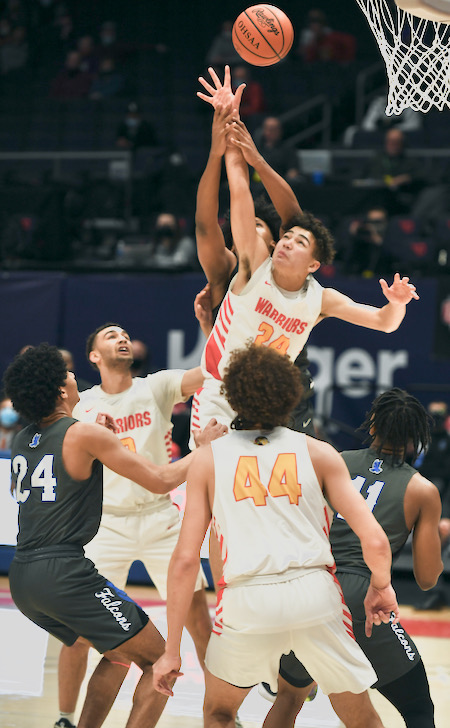Pursuant to our March 15 column, and the recent ‘Reader Speaks’ page that shared readers’ opinions on the state of rough play in basketball – a final word before we embark upon a new season and the ‘timid’ play set forth for amateur baseball.
 Before anyone writes to complain about criticizing high school basketball officials, and the lament that they’re a necessary and under-appreciated part of the game (and they are), some final words pertaining to remarks received this week about the recently completed boys state tournament and those who wrote to say: “There are apparently rules for teams that are skilled, and rules for teams that are just bigger and more physical.”
Before anyone writes to complain about criticizing high school basketball officials, and the lament that they’re a necessary and under-appreciated part of the game (and they are), some final words pertaining to remarks received this week about the recently completed boys state tournament and those who wrote to say: “There are apparently rules for teams that are skilled, and rules for teams that are just bigger and more physical.”
And it wasn’t one email, or Facebook message, or tweet. There were several – people who watched, and noted, and in some cases used our own photos as evidence that there’s “far too much physical contact” in basketball for the game to be fair and ethical.
To wit:
“The Division III game between Worthington Christian and Lutheran East was absurd,” wrote Kevin Hoak. “In his own story [Press Pros] writer Bruce Hooley admitted that it was ‘way too physical’. Two styes, finesse and shooting, and size and physical, and every time that Worthington’s DJ Moore’s ability to score threatened Lutheran East he got hammered. He later said, and this is his quote, ‘They were playing really rough. I was getting bumped, getting pushed off the ball, all game.‘
 “To your earlier post (Mar. 15) that said fans who watch don’t know what’s going on, you couldn’t be more accurate. But the players obviously do. And why is it this way…where shooting and skill take a back seat to physical, rough play? Look at the photos that YOU published with the story. Three officials, and apparently none of the three see these violations. A lot of us would like to know, how does it get better, and who’s responsible for change?”
“To your earlier post (Mar. 15) that said fans who watch don’t know what’s going on, you couldn’t be more accurate. But the players obviously do. And why is it this way…where shooting and skill take a back seat to physical, rough play? Look at the photos that YOU published with the story. Three officials, and apparently none of the three see these violations. A lot of us would like to know, how does it get better, and who’s responsible for change?”
Well the fault does not lie with individual officials who actually work the games. As I wrote on March 15, as a young official working in the 70s I was taught to call contact, call it early, and establish by the end of the first quarter what would be allowed and what wouldn’t.
What you’re seeing is an evolution of thought in the past four decades that since kids are now bigger, stronger, and faster, they should be allowed to play with more aggression – that somehow that makes for a better, and athletically interesting game.
The verdict is out on that, apparently, as many people who watch think that basketball now resembles mixed martial arts, as it is allowed in the urban leagues of Cincinnati, Dayton, and Columbus. And if that bothers you, don’t even bother to watch Big Ten basketball, just one step up from high school.
But to reiterate, this is not the fault of the officials. They do as they’re instructed, and they’re instructed through the auspices of the National Federation of High School Sports Association, headquartered in Indianapolis, where former high school principal, coach, and athletic director Karissa Niehoff is the Executive Director.
Niehoff, by the way, coached women’s field hockey, not basketball, and in a published interview with Referee Magazine last year said:
“The perspective of the official is critical to how rules are developed, the content, how they’re written, and the language, based on an interpretation issue. If (officials) can really add a voice, their perspective, it provides us insight with how well a rules manual can be interpreted with consistency, understood with consistency, implemented with consistency, and how the relationship then between coaches and teams and officials during a contest can be smooth, based on how well we understand the rules. It all goes right back into that committee room when we’re thinking about changes to rules. We absolutely have to have (the officials’) perspective.”
Seriously, if you took the time to read, did you understand that? C’mon man…..
Three times she mentioned consistency, but based on interpretation (her words), contact in amateur basketball – basketball at all levels – has become a muddled mess when you have a split second to determine whether getting bumped or grabbed or pushed creates an advantage for one and a disadvantage for another. And it’s hard TO HAVE CONSISTENCY because officials aren’t robots. So to the thousands who watch, like Kevin Hoak, they say…just blow the whistle. Because if you blow it enough they have to clean it up!
And at the same time…ironic, for the fact that baseball season is upon us and the National Federation has done everything possible to eradicate hard play in that sport – pitching inside, breaking up double plays, and no contact between base runners trying to score, and the catcher – in order to make the game safer.
 How can this be cleaned up? The answer is coaches. They allow for this, and promote it in cases when it benefits their cause – proud of the image of leagues with a reputation for physical play. If coaches said we want a game predicated on skills and shooting…there would be change.
How can this be cleaned up? The answer is coaches. They allow for this, and promote it in cases when it benefits their cause – proud of the image of leagues with a reputation for physical play. If coaches said we want a game predicated on skills and shooting…there would be change.
Or, do nothing, and move on with the growing frustration of schools who stress skill and shooting and don’t have a snowball’s chance of beating a team that chooses to play a more physical style of basketball. I was at that game with Lutheran East, and East WAS NOT so much athletically superior, they just chose to play a different style. DJ Moore scored 28 points and got pushed and grabbed a lot. East’s Jalin Billingsly scored 24 and did not.
Critics will say that Worthington Christian needed to adapt. But why does one team and not the other?
This is what the people who watch want to know. Basketball as it’s played now is anything but smooth, and to Ms. Niehoff’s concern, people DON’T understand the rules – not anymore.
Just that one team, in this case, was disadvantaged.

